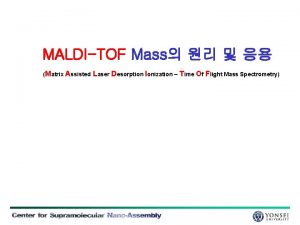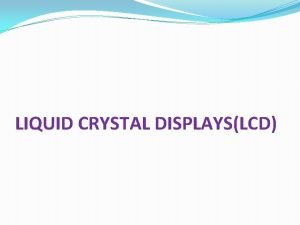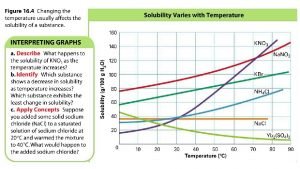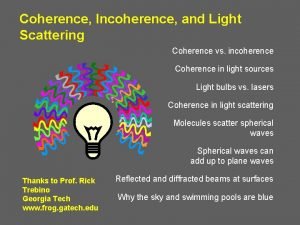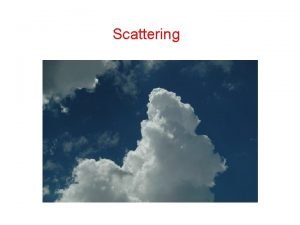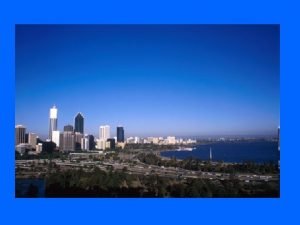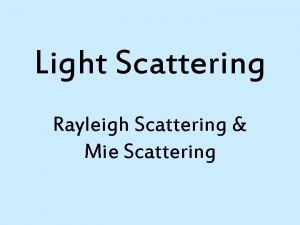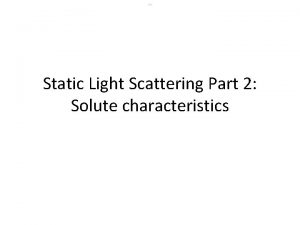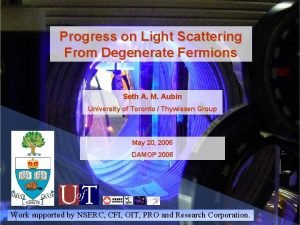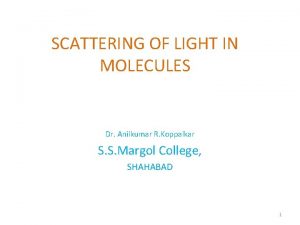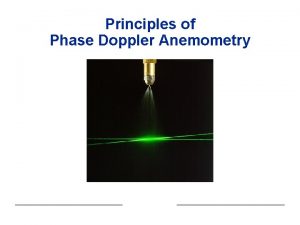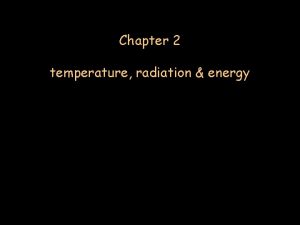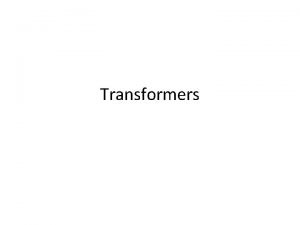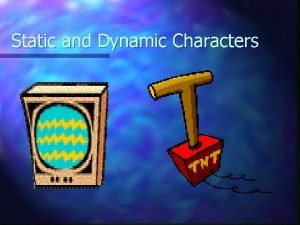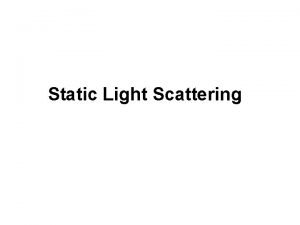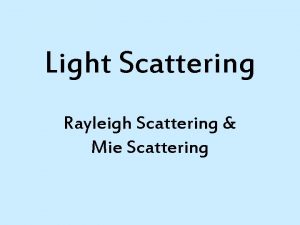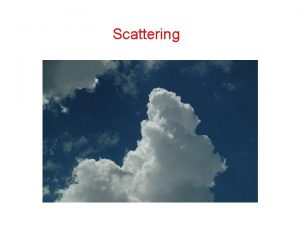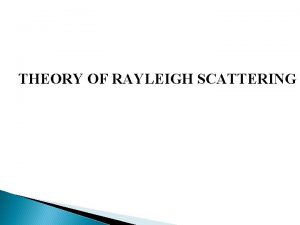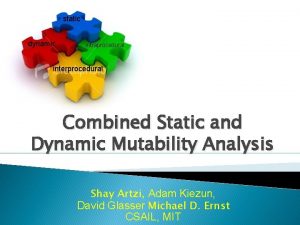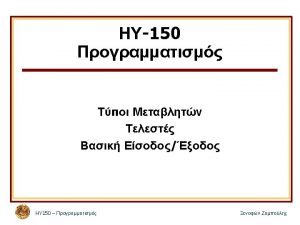Static Dynamic Light Scattering First quantitative experiments in























- Slides: 23

Static & Dynamic Light Scattering • First quantitative experiments in 1869 by Tyndall (scattering of small particles in the air – Tyndall effect) • 1871 – Lord Rayleigh started a quantitative study and theory • Basic idea: incident monochromatic linearly polarized light beam incident on a sample. Assume – No absorption – Randomly oriented and positioned scatterers – Isotropic scatterers – Independently scattering particles (dilute) – Particles small compared to wavelength of light We’ll remove some of these restrictions later

Classical Wave description • The incident electric field is E = Eocos(2 px/l – 2 pt/T) • Interaction with molecules drives their electrons at the same f to induce an oscillating dipole pinduced = a Eocos(2 px/l – 2 pt/T) - a = polarizability • This dipole will radiate producing a scattered E field from the single molecule dipole f r Obs. Pt.

Static (or time-average)Rayleigh scattering 1. E ~ 1/r so I ~ 1/r 2 - necessary since I ~energy/time/area and A ~ r 2 2. E ~ 1/l 2 dependence so I ~ 1/l 4 – blue skies and red sunsets (sunrises) 3. Elastic scattering – same f 4. sin f dependence – when f = 0 or p – at poles of dipole – no scattering – max in horizontal plane 5. a related to n , but how?

Polarizability and index of refraction • Note that if n ~ 1 where c is the weight concentration • Then where N = number concentration • So, • For a particle in a solvent with nsolv, we have n 2 – n 2 solv = 4 p. Na so

Scattered Intensity • Detect intensity, not E, where • Substituting for a, we have

Scattered Intensity II • If there are N scatterers/unit volume and all are independent with N = NAc/M, then • We define the Rayleigh ratio Rq:

Basic Measurement • If the intensity ratio Iq/Io, nsolv, dn/dc, l, c, f, and r are all known, you can find M. • Usually write Kc/Rq = 1/M • Measurements are usually made as a function of concentration c and scattering angle q • The concentration dependence is given by where B is called thermodynamic virial – same as we saw before for c dependence of D (but called A) q

Angle Dependence • If the scatterers are small (d < l/20), they are called Rayleigh scatterers and the above is correct – the scattering intensity is independent of scattering angle • If not, then there is interference from the light scattered from different parts of the single scatterer • Different shapes give different particle scattering factors P(q) q. R~q From P(q), we can get a Radius of Gyration for the scatterer

Analysis of LS Data • Measure I(q, c) and plot Kc/Rq vs sin 2(q/2) + (const)c – Extrapolations: c q 0 0

Final result Slope~RG intercept Slope~B Problems: Dust, Standard to measure Io, low angle measurement flare

Polydispersity • If the solution is polydisperse – has a mixture of different scatterers with different M’s - then we measure an average M – but which average? • So the weight-averaged M is measured! Possible averages: Number-average Weight-average Z-average

Dynamic Light Scattering - Basic ideas – what is it? - The experiment – how do you do it? - Some examples systems – why do it?

Double Slit Experiment Coherent beam Extra path length screen + =

Light Scattering Experiment Scatterers in solution (Brownian motion) Scattered light Laser at fo Narrow line incident laser Doppler broadened scattered light Df 0 is way off scale fo Df ~ 1 part in 1010 - 1015 f

More Detailed Picture detector q Inter-particle interference Detected intensity Iaverage time How can we analyze the fluctuations in intensity? Data = g(t) = <I(t) I(t + t)>t = intensity autocorrelation function

Intensity autocorrelation • g(t) = <I(t) I(t + t)>t t For small t For larger t t g(t) tc t

What determines correlation time? • Scatterers are diffusing – undergoing Brownian motion – with a mean square displacement given by <r 2> = 6 Dtc (Einstein) • The correlation time tc is a measure of the time needed to diffuse a characteristic distance in solution – this distance is defined by the wavelength of light, the scattering angle and the optical properties of the solvent – ranges from 40 to 400 nm in typical systems • Values of tc can range from 0. 1 ms (small proteins) to days (glasses, gels)

Diffusion • What can we learn from the correlation time? • Knowing the characteristic distance and correlation time, we can find the diffusion coefficient D • According to the Stokes-Einstein equation where R is the radius of the equivalent hydrodynamic sphere and h is the viscosity of the solvent • So, if h is known we can find R (or if R is known we can find h)

Why Laser Light Scattering? 1. 2. 3. 4. 5. Probes all motion Non-perturbing Fast Study complex systems Little sample needed Problems: Dust and best with monodisperse samples

Aggregating/Gelling Systems Studied at Union College • Proteins: – Actin – monomers to polymers and networks Study monomer size/shape, polymerization kinetics, gel/network structures formed, interactions with other actin-binding proteins Why? Epithelial cell under fluorescent microscope Actin = red, microtubules = green, nucleus = blue

Aggregating systems, con’t – BSA (bovine serum albumin) – beta-amyloid +/- chaperones – insulin what factors cause or promote aggregation? how can proteins be protected from aggregating? what are the kinetics? • Polysaccharides: – Agarose – Carageenan Focus on the onset of gelation – what are the mechanisms causing gelation? how can we control them? what leads to the irreversibility of gelation?

Current Projects 1. b-amyloid – small peptide that aggregates in the brain – believed to cause Alzheimer’s disease-

2. Insulin aggregation Current Projects • EFFECTS OF ARGININE ON THE KINETICS OF BOVINE INSULIN AGGREGATION STUDIED BY DYNAMIC LIGHT SCATTERING • • By Michael M. Varughese • ***** • • • Submitted in partial fulfillment of the requirements for Honors in the Department of Biological Sciences and done in conjunction with the Department of Physics and Astronomy UNION COLLEGE June, 2011 • • •
 Dynamic light scattering 원리
Dynamic light scattering 원리 Dynamic scattering type lcd
Dynamic scattering type lcd Scattering of light in suspension
Scattering of light in suspension Scattering of light definition
Scattering of light definition Area of cross section
Area of cross section Rayleigh scattering
Rayleigh scattering Mie plot
Mie plot Rayleigh theory of light scattering
Rayleigh theory of light scattering Pauli blocking of light scattering in degenerate fermions
Pauli blocking of light scattering in degenerate fermions Scattering of light
Scattering of light Light scattering
Light scattering Vertical
Vertical Light light light chapter 23
Light light light chapter 23 Light light light chapter 22
Light light light chapter 22 Chapter 22
Chapter 22 Object diagram captures the behavior of a single use case.
Object diagram captures the behavior of a single use case. Why transformer is a static device
Why transformer is a static device Great gatsby nick appearance
Great gatsby nick appearance Static and dynamic in literature
Static and dynamic in literature Dynamic vs static character
Dynamic vs static character Dynamic vs round character
Dynamic vs round character Static routing and dynamic routing
Static routing and dynamic routing Wang xiaomin
Wang xiaomin Static or dynamic character
Static or dynamic character
